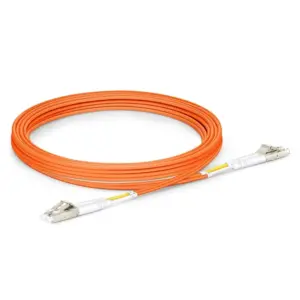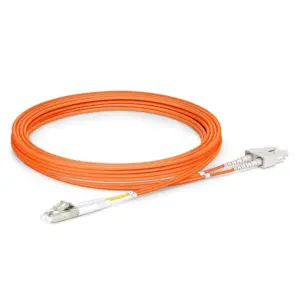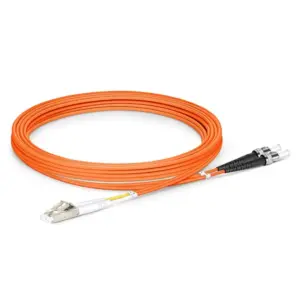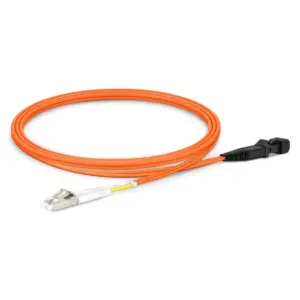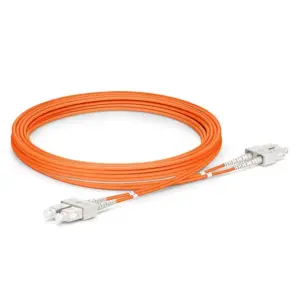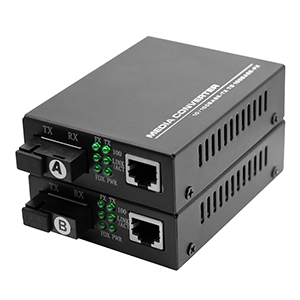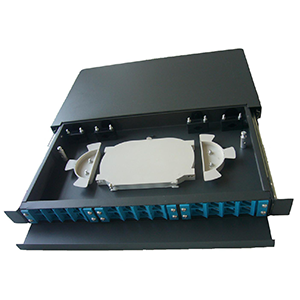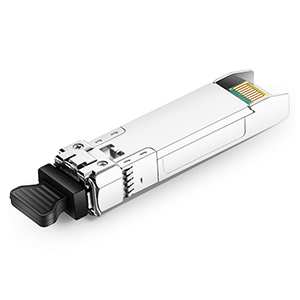As a common multi-mode optical fiber jumper, OM2 plays an important role in the field of optical fiber transmission. In this article, we will introduce the basic concepts, characteristics and use of OM2 fiber optic patch cords in different application fields. We will also discuss the structure and parameters of OM2 fiber optic jumpers, transmission performance and comparison with other fiber grades. Finally, we will discuss the deployment, maintenance considerations and future development trends of OM2 fiber optic patch cords.
Introduction to OM2 fiber optic patch cord
Definition and characteristics:
OM2 fiber optic patch cord is a multi-mode fiber optic patch cord used to transmit optical signals in applications such as local area networks (LAN) and data centers. It is a fiber grade commonly used in fiber optic communications.
OM2 optical fiber patch cord uses multi-mode optical fiber, which has high bandwidth and transmission performance. It is typically used for data transmission over shorter distances and at medium speeds. OM2 fiber optic patch cord supports 1Gbps (gigabits per second) optical signal transmission and is suitable for network applications based on Ethernet and Fast Ethernet.
Multimode optical fiber classification:
Within the classification of multimode fiber optic patch cords, different standards and levels are used to describe their performance and characteristics. The following are the OM2 levels in the fiber optic patch cord classification and their characteristics:
OM2 grade fiber optic patch cord is a 50/125 micron multi-mode fiber optic patch cord. The numbers 50 and 125 represent the fiber’s core diameter and cladding diameter, respectively, in microns. This fiber uses light wavelengths of 850 nanometers or 1300 nanometers in optical signal transmission.
OM2 optical fiber jumpers have higher bandwidth and transmission capabilities than lower-level optical fibers (such as OM1 level). It can support optical signal transmission rates up to 1Gbps and is suitable for Ethernet, Fast Ethernet and some fiber optic communication applications.
It should be noted that the transmission distance of OM2 fiber optic jumpers is shorter than that of OM3 and OM4 grade fiber optic jumpers. Generally speaking, the transmission distance of OM2 fiber optic patch cord is less than one kilometer, which is suitable for shorter distance data transmission needs.
OM2 fiber optic patch cord is a commonly used multi-mode fiber optic patch cord, suitable for short distance and medium speed data transmission. It has 50/125 micron optical fiber specifications and can support 1Gbps optical signal transmission rate. When selecting fiber optic patch cords, the most appropriate fiber grade needs to be determined based on specific application requirements and transmission distance.
Structure and parameters of OM2 fiber optic patch cord
structure:
The structure of OM2 fiber optic patch cord is similar to other multimode fiber optic patch cords and usually consists of the following parts:
-
Fiber optic core (Core): The fiber optic core is the central part of optical signal transmission and is composed of high refractive index material (usually glass). In OM2 fiber optic patch cords, the fiber core diameter is 50 microns.
-
Cladding: The cladding is the outer layer of the optical fiber core. It is made of low-refractive index material (usually silicon) and is used to keep the optical signal in the optical fiber core. In OM2 fiber optic patch cords, the cladding diameter is 125 microns.
-
Jacket: The jacket is the outer layer that protects the optical fiber. It is usually made of materials (such as PVC or LSZH) that are wear-resistant, pressure-resistant, and flame-retardant. Jackets provide protection for optical fibers from physical damage and environmental influences.
parameter:
OM2 fiber optic patch cord has the following important parameters:
-
Core Diameter: The fiber core diameter of OM2 fiber optic jumper is 50 microns. It determines the path of optical signal transmission in the optical fiber.
-
Mode Field Diameter: The mode field diameter refers to the diameter of the mode field of the optical signal (that is, the light intensity distribution propagating in the optical fiber). In OM2 fiber optic patch cords, the typical mode field diameter is approximately 8.6 microns.
-
Typical Attenuation: Attenuation is the signal loss of optical signals during optical fiber transmission. Typical attenuation levels for OM2 fiber optic patch cords are 0.5 to 3.5 decibels (dB) per kilometer.
These parameters are important indicators used to describe and evaluate the performance and transmission characteristics of OM2 fiber optic patch cords. Smaller core diameter and mode field diameter, lower typical attenuation values can provide better transmission performance and shorter transmission distance.
It should be noted that specific OM2 fiber optic patch cord parameters may vary depending on manufacturers and suppliers. When selecting and using OM2 fiber optic patch cords, it is recommended to refer to the relevant technical specification sheets and data provided by the supplier to ensure that it meets the required performance requirements.
Application areas of OM2 fiber optic patch cord
Local Area Network (LAN):
OM2 fiber optic patch cords are widely used in enterprise and campus LANs. It provides high bandwidth and reliable fiber optic connections for shorter distance data transmission needs. The following is the application of OM2 optical fiber patch cord in LAN:
-
Enterprise internal network: Enterprises often use OM2 optical fiber jumpers to connect offices, computer rooms, servers and other equipment. It can support high-speed data transmission and meet the needs of corporate internal networks.
-
Campus network: In the campus environment, OM2 optical fiber patch cords are used to connect various buildings such as teaching buildings, libraries, laboratories, etc. to achieve high-speed data exchange and resource sharing.
Data center network:
OM2 fiber optic patch cords are also widely used in data center networks. Data centers often require high-capacity, high-speed and low-latency data transmission, and OM2 fiber optic patch cords can meet some of these requirements. The following is the use of OM2 fiber optic patch cords in data center networks:
-
Server connection: OM2 fiber optic jumpers can be used to connect servers, storage devices and network devices in data centers. It provides high-speed, reliable connectivity, supporting fast data transfer and communication within the data center.
-
Data center interconnection: When multiple data centers need to be interconnected, OM2 optical fiber jumpers can be used to build optical fiber links between data centers. It provides high-bandwidth and low-latency connections to support data sharing and backup between data centers.
It should be noted that as technology continues to advance, higher-grade fiber optic patch cords (such as OM3, OM4 or single-mode fiber) may be more common in some applications, especially when longer transmission distances or higher rate. But for some small and medium-sized LANs and data center networks, OM2 fiber optic patch cords are still an economical and practical choice.
Transmission performance of OM2 optical fiber jumper
Transmission distance:
The transmission distance of OM2 fiber optic patch cord is relatively short and mainly depends on the type of fiber and transmission rate. Generally speaking, the transmission distance of OM2 fiber optic patch cord can reach the following range:
-
1Gbps transmission rate: At a transmission rate of 1Gbps (gigabits per second), the transmission distance of OM2 fiber optic patch cord can reach approximately 550 meters.
-
10Gbps transmission rate: At the transmission rate of 10Gbps (10 gigabits per second), the transmission distance of OM2 fiber optic patch cord is significantly shortened, generally no more than about 82 meters.
It should be noted that these transmission distances are based on standard OM2 optical fiber and good connection conditions. Different fiber qualities, connectors, and environmental factors may affect actual transmission distance.
Transmission rate:
OM2 fiber optic patch cord shows different performance at different transmission rates. The following is performance at common transfer rates:
-
1Gbps transmission rate: OM2 optical fiber jumper can support 1Gbps transmission rate and is suitable for network applications based on Ethernet and Fast Ethernet. It provides stable high-bandwidth transmission and is suitable for most LAN and data center applications.
-
10Gbps transmission rate: OM2 fiber optic patch cord has a shorter transmission distance at the 10Gbps transmission rate and is affected by more attenuation. Therefore, for 10Gbps transmission requirements, usually the more common choice is OM3 or OM4 grade fiber optic patch cords.
OM2 fiber optic patch cord has good performance at 1Gbps transmission rate and is suitable for most small and medium-sized LAN and data center networks. When higher transmission rates or longer transmission distances are required, higher-level fiber optic patch cords may need to be considered. When selecting fiber optic patch cords, it is recommended to refer to specific application requirements and technical specifications to ensure the most appropriate fiber grade and specification are selected.
Comparison of OM2 fiber optic patch cords with other fiber grades
- Comparison of OM2 fiber optic patch cords with other fiber optic grades
Performance comparison:
There are some performance differences between OM2 fiber optic patch cords and other multimode fiber grades (such as OM1, OM3, OM4). Here are some comparisons between them:
-
Transmission rate: OM2 fiber optic patch cord can support a transmission rate of 1Gbps, while OM3 and OM4 fiber optic patch cord can support higher transmission rates, such as 10Gbps, 40Gbps, 100Gbps or even higher. The transmission rate of OM1 fiber optic patch cord is relatively low and is generally suitable for low-speed applications.
-
Transmission distance: The transmission distance of OM2 fiber optic patch cord is relatively short, especially under high-speed transmission. OM3 and OM4 fiber optic patch cords can support longer transmission distances, especially when transmitting at high speeds. The transmission distance of OM1 fiber optic patch cord is generally shorter.
-
Attenuation: The typical attenuation range of OM2 fiber optic patch cords is 0.5 to 3.5 decibels (dB) per kilometer. OM3 and OM4 fiber optic patch cords generally have lower attenuation and can support longer transmission distances. The attenuation of OM1 fiber optic patch cord is relatively high.
Applicable scene:
When selecting OM2 fiber optic patch cords or other fiber optic grades, you need to consider your specific network environment and application needs. Here is some guidance on best practices:
-
OM2 fiber optic patch cord: OM2 fiber optic patch cord is suitable for most small and medium-sized LANs and data center networks, especially for applications with 1Gbps transmission rate. It provides reliable high-bandwidth transmission over limited distances.
-
OM3 fiber optic patch cord: OM3 fiber optic patch cord is suitable for applications requiring higher transmission rates (such as 10Gbps, 40Gbps) and longer transmission distances. It is widely used in data centers, enterprise networks and high-performance computing environments.
-
OM4 fiber optic patch cord: OM4 fiber optic patch cord is an ideal choice in high-performance networks that require higher transmission rates and longer transmission distances. It performs well in high-rate transmission scenarios such as 10Gbps, 40Gbps, and 100Gbps.
-
OM1 fiber optic patch cord: OM1 fiber optic patch cord is suitable for lower speed and shorter distance applications, such as traditional Ethernet and Fast Ethernet networks. But in new network deployments, it is gradually replaced by higher-level fiber optic patch cords.
The appropriate level of fiber needs to be selected based on specific network requirements and budget. When selecting fiber optic patch cords, it is recommended to work with the supplier to understand the performance characteristics of various fiber grades and make decisions based on actual needs.
Precautions for deployment and maintenance of OM2 fiber optic patch cord
Installation and connection:
When installing and connecting OM2 fiber optic patch cords, you need to follow the following precautions:
-
Ensure proper handling and protection: When handling OM2 fiber optic patch cords, avoid excessive bending, pulling, or damaging the fiber. It is important to maintain the integrity of the fiber to ensure proper signal transmission.
-
Clean the connector end face: Before connecting the OM2 fiber optic patch cord, be sure to clean the connector end face to ensure good optical performance. Use dedicated fiber optic cleaning tools and alcohol-free cleaners to carefully clean connector end faces to avoid scratches or contamination.
-
Pay attention to connector alignment: When connecting the OM2 fiber optic patch cord, make sure the connector is properly aligned and inserted into the port. Avoid applying excessive force to avoid damaging the connector.
-
Protect the connection: Once the connection is made, use appropriate connection protection, such as protective sleeves, jackets, or fiber optic distribution boxes, to protect the connector from physical damage or environmental contamination.
Maintenance and care:
In order to ensure the good performance and reliability of OM2 fiber optic patch cords, regular maintenance and upkeep is required. Here are some key takeaways:
-
Regular cleaning: Clean the connector end face regularly to remove impurities such as dirt, dust, or fingerprints. Use dedicated fiber optic cleaning tools and alcohol-free cleaners for cleaning, and follow the instructions for the cleaning tools and cleaners.
-
Protect fiber optic patch cords: Ensure fiber optic patch cords are properly protected from excessive bending, pulling, or severe twisting. Protect fiber patch cords from physical damage by using equipment such as jackets, protective sleeves, or fiber optic distribution boxes.
-
Regular inspection: Regularly check the appearance of fiber jumpers and connectors, and whether the connections are secure. If any abnormalities or damage are found, repair or replace them promptly.
-
Environmental protection: Ensure that the environment where the OM2 fiber optic patch cord is located is dry and clean, and avoid excessively high or low temperatures. Avoid exposing fiber patch cords to harmful chemicals or strong light.
The frequency of maintenance and upkeep depends on the environment and conditions in which the fiber optic patch cord is used. In general, regular cleaning and inspection can help ensure good performance and reliability of fiber optic patch cords. If you encounter problems or require professional support, it is recommended to consult a fiber optic network expert or supplier.
Future development trend of OM2 optical fiber patch cord
As new generations of standards and technologies continue to develop, OM2 fiber optic patch cords may face some challenges and changes. Next-generation standards may offer higher transmission rates and longer transmission distances to meet growing data demands. In addition, the development of optical fiber networks will also promote the further application and innovation of OM2 optical fiber jumpers, providing more reliable data transmission solutions for all walks of life.
Summarize:
OM2 fiber optic patch cord, as a grade of multi-mode fiber optic patch cord, plays an important role in LAN and data center networks. It has a certain transmission performance and application range and can support data transmission requirements of different transmission distances and rates.
When selecting and deploying OM2 fiber optic patch cords, consider how it compares to other fiber optic grades based on your specific needs and budget, and follow proper installation and maintenance practices to ensure optimal performance and reliability. In the future, with the development of technology, OM2 fiber optic patch cords are expected to continue to play an important role in fiber optic networks and adapt to the growing demand for data transmission.


